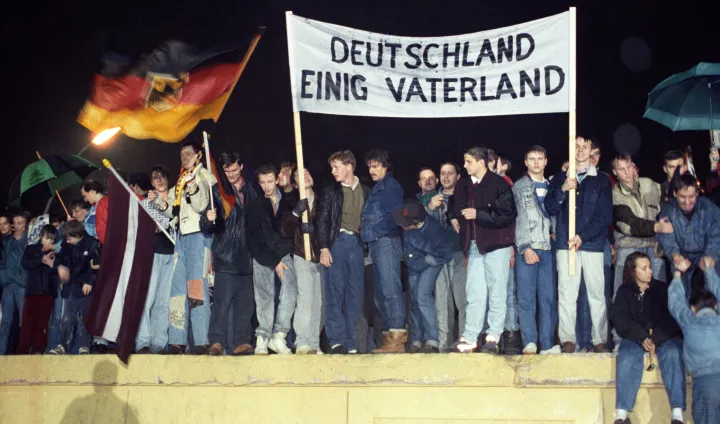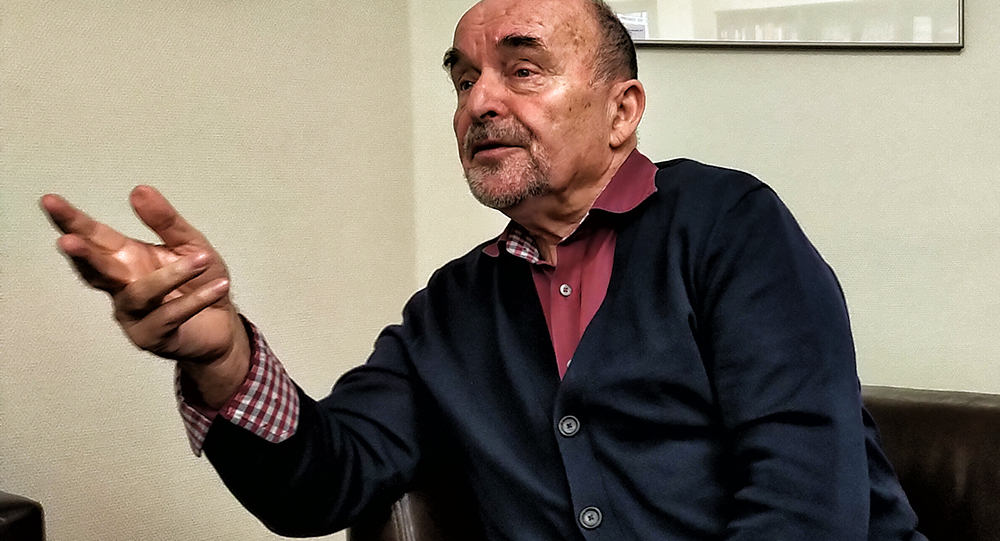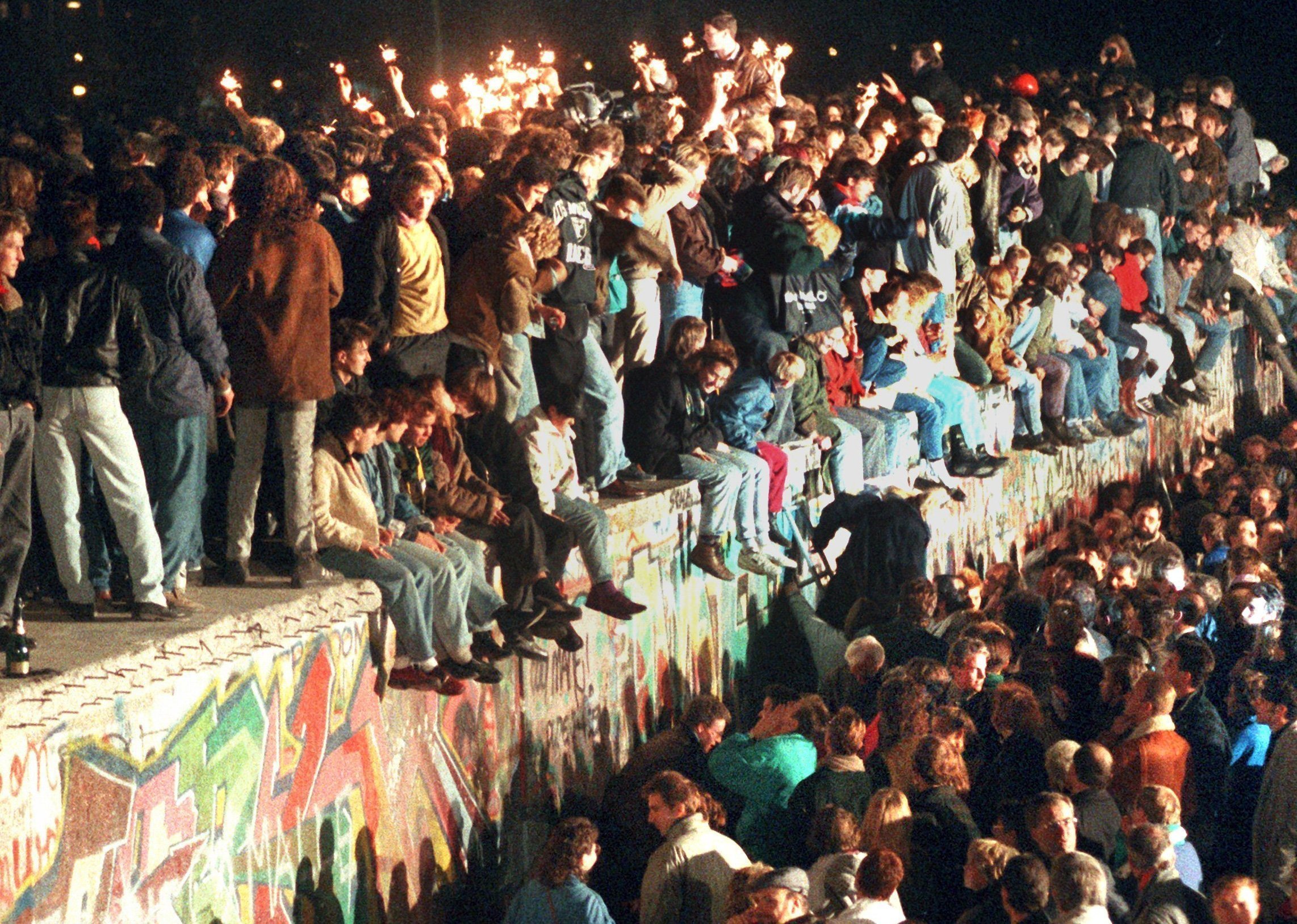MONUMENT TO CHANGE
More than a few bricks in the Berlin Wall

Berlin was a Cold War hot-spot. But its dark and grim history set against the extraordinary occurrence of 30 years ago should also remind us how suddenly things can catalyse and change for the better. The events of 9 November 1989 should prompt us never to take democracy for granted, just as they should urge leaders to be bold and brave in their reforms.
“The problem with socialism is that you eventually run out of other people’s money.” Usually attributed to Margaret Thatcher, this statement helps to explain why the German Democratic Republic, or “DDR”, collapsed. Communism eventually failed when it could not deliver what its people craved and when its sources of external supply became unattainable.
East Germany was pretty good at providing the basics to its citizens, including rudimentary prefabricated housing, food staples and even “people’s cars” in the form of the smoky Trabant and clunky Wartburg.

A file picture dated 11 November 1989 shows GDR cars rolling across the border into West Germany at the crossing in Herleshausen, Germany. The 25th anniversary of the fall of the Berlin Wall will be celebrated in Berlin on 09 November 2014. EPA/KAI-UWE WAERNER
But its people wanted more. West Germany was a constant reminder of their relative poverty and backwardness. There was an insufficient investment in technology and education to compete, and a lack of (basically financial) incentives to inspire its workers to great heights. The best the East could hope for was to be a cheap labour reservoir for Western companies.
The socialist model also proved financially unsustainable. Prices were set by the government, not through the pressures of competition, supply and demand. Its state-owned enterprises were cumbersome and inefficient, not able to survive in a commercial world, and produced goods that few preferred.
But there was fundamentally more to failure than economic goodies alone. For one, there was no political competition. The DDR was effectively a one-party state, governed by the Socialist Unity Party (SED) through an alliance, the National Front of Democratic Germany.
“Undemocratic regimes need prisons to isolate critical people around whom oppositions can be organised,” observed the guide at Berlin-Hohenschönhausen jail to the city’s north-east. Once a Nazi labour camp converted into an internment centre by the Soviets after the war, from 1951 the prison became the heart of a sprawling security complex for political prisoners, with its 200 cells and interrogation rooms. Prisoners were held on remand “to break their spirit, intimidate and humiliate them”. It was, said the guide, “the dark side of the communist regime, reminding how important is democracy, and how dangerous is propaganda”.
Simply stating an intention to leave the DDR could get an 18-month sentence. Some 72,000 citizens were jailed for trying to leave, of more than 200,000 political prisoners over the four decades of the DDR.

A file photo dated 11 November 1989 shows East Berlin residents waiting to cross into the West Berlin at the new border crossing on Bernauer Strasse after the fall of the Berlin Wall in Berlin, Germany. After the new travel laws went into effect in the former GDR and the border was opened on 09 November 1989, millions of East Germans streamed across the border into West Berlin. The 25th anniversary of the fall of the Berlin Wall will be celebrated in Berlin on 09 November 2014. EPA/STR
This was just one grim aspect of a brutal security regime. The Ministry for State Security, commonly known as the Stasi, saw itself as an elite group of “first-class comrades” serving “the dictatorship of the proletariat”. With a goal “to know everything”, by 1998 the Stasi employed a vast network of more than 90,000 agents and at least 189,000 “unofficial collaborators”, though the total of “information providers”, or Auskunftspersonen, was a staggering two million.
Despite the menace, East Germans routinely made light of their plight, humour useful in keeping spirits up during the dark days.
“Why do the Stasi work together in groups of three?” they asked. “You need one who can read, one who can write, and a third to keep an eye on the two intellectuals.”
Still, there was an intrusive level of menace and fear. Private rights were easily trumped by regime interests and security. Mail was steamed open, conversations bugged and painstakingly transcribed, groups infiltrated and people tailed and photographed. Some 20,000 Personal Surveillance Operations (OPK) were being processed by the end of 1989. The Nazi hunter Simon Wiesenthal said of the Stasi that it “terrorised their own people worse than the Gestapo.”
Erich Mielke, the Stassi’s boss for 32 years until 1989, summed up its purpose as a “constant effort to clarify ‘who is who’… to identify people’s true political attitudes, their way of thinking and behaving… providing an answer to who is the enemy; who is taking on a hostile or negative attitude; who is under the influence of hostile, negative and other forces and may become an enemy; who may succumb to enemy influences and allow himself to be exploited by the enemy; who has adopted a wavering position; and who can the party and state depend on and be reliably supported by?’
A convicted assassin, Mielke lamented before his death in 2000 aged 92:
“If the party had given me the task, then there would perhaps still be a DDR today. On that you can rely.”
The agents had their agents and they were, in turn, monitored by the system. This Orwellian world is the subject of the 2006 film The Lives of Others, a dark drama which follows the career of an agent, code name HGW XX/7, who protects his subject to his cost. The officer’s sinister professionalism and loyalty are expected, as is the pettiness and spite, corruption, self-interest and kow-towing humiliation in a world of betrayal and scheming, informers and conformists. That HGW XX/7’s detached investigation gradually gives way to curiosity and cautious decency, is a metaphor for the exhaustion and self-loathing which caused, eventually, the DDR to collapse.

Photo: Father Rainer Eppelmann was an opposition leader in the DDR, the subject of the attention of more than 100 Stasi agents. (Greg Mills)
Rainer Eppelmann, 76, was a famed opposition figure in the DDR who became the first (and last) civilian minister of disarmament and defence in 1990 as it folded into West Germany. Of The Lives of Others he says “even though a feature, and not a documentary, the film shows very clearly the inhumane system, and lifted the veil from the DDR”.
Like all good bureaucrats, the Stasi kept meticulous records. Reams and cellars of the stuff, an estimated one billion pages, were written down or typed, and filed away, most of which were preserved and are now publicly available. The spy agency assembled files on 5.4 million people, one-third of the DDR’s population.
Just imagine if they had put that energy into something useful?
In the 30 years since the fall of the wall, it is easy to gloss over the excesses of the eastern bloc and Soviet-led system. These are forgotten by those retaining nostalgia for the DDR — known colloquially as Ostalgie. There is a word, too, for whining easterners, or Jammerossis, and in response for those from the West who apparently know better, or Besserweissis.
Labels and rhetoric aside, this frustration hints at the difficulty of redistribution as an effective and efficient tool of change, even though there was a little option.
To uplift the standard of living, since 1991 German taxpayers have been charged an additional 5.5% surcharge on their personal income, capital gains and corporate tax bill towards a “Solidarity Tax” (Solidaritaetszuschlag). The surcharge was initially levied for only one year and amounted to 7.5% of the tax bill of wage earners and companies, reduced to 5.5% in 1998. By 2010 it had generated an estimated €200-billion for the government’s coffers. So far, reunification is estimated to have cost the federal government €2-trillion, about two-thirds of this being for social welfare payments.
The results?
It is unsurprising that the process of reunification has been more difficult and costly than imagined, given the East’s comparative lack of technology, infrastructure and weak education system where rote learning rather than excellence was the norm. With it went a statist mindset; that the state would provide, not enough perhaps to enjoy yourself, but enough to survive, whatever you did, with room for initiative and individualism. This produced a Wendeshock, a profound “personal shock”, says Walter Kohl, the son of the former chancellor, “from having a complete change of political and economic system”.

A file photo dated 11 November 1989 shows people celebrating the opening of the border between East and West Germany on the Berlin Wall in Berlin, Germany. After the border was opened, millions of East Germans streamed across the border into West Berlin. The 25th anniversary of the fall of the Berlin Wall will be celebrated in Berlin on 09 November 2014. EPA/STR
Economically, the two Germanys were initially entirely incompatible. East German industry was largely incapable of competing on the international market. It had too many employees, productivity was low, technology poor, and the quality of its products from the two-stroke Trabant to the clunky Praktica camera did not cut it among Western consumers.
Its problem ran deeper than the DDR and post-1945 history, however. East Germany was formed on the rump of the old Prussia, described not as a state with an army, but “an army with a state”. Agricultural and militarised, its conversion into something new would take time, even though the Soviet army had, in 1945, smashed forever the Prussian military legend.
Yet there was little alternative to integrating the two German societies and systems. As the former West German Chancellor Willi Brandt put it, what belonged together now had to grow together: politically, geographically, and socially. That this subsidy has been provided only to the East has become contentious, with some regions in the West (such as in the former Ruhr industrial heartland) suffering from similar conditions to those the eastern states endured shortly after unification: industrial decline, high unemployment, migration away from the area, and high levels of municipal debt. The old East-West divisions no longer definitively reflect the spread of wealth countrywide, even though per-capita GDP of the East is today around three-quarters of that in the old West.
Three lessons stand out 30 years on from East Germany’s economic transition:
First, change depends less on good governance (though corruption is costly), or any attempts to improve the efficiency of state agency, but structural reform.
Second, there are few quick fixes, including through redistribution.
An estimated 90% of Dresden’s buildings were destroyed in World War II, much of the destruction occurring at the hands of the allies in February 1945, when an estimated 25,000 civilians were killed. Even though its economy prospered with the development of a hi-tech so-called Silicon Saxony, rebuilding the city has taken much longer and continues today, the landmark Frauenkirche only being completed in 2005. Reform is a marathon without a finishing line.
And third, it was critical, in this, says Eppelmann, to ensure that “West Germans were not worse off than before integration”. If they were, they would have been resentful of the price paid.
Of course, he admits, the fall of the wall was an “intoxicating” moment, “like the start of a honeymoon. Now we have been married for 30 years. Inevitably”, he smiles, “it’s a different situation”.
There are other, political lessons from the fall of the wall.
While the Stasi protected the state, and the privileges of the elite, it clearly needed to be guarded against. The same is true for other, contemporary praetorians.
Stasi methods are as tempting to authoritarians and populists as they were during the Cold War, particularly the more indirect forms of intimidation, surveillance and control Its agents perfected a technique known as Zersetzung (decomposition), the continual psychological harassment aimed at damaging the reputations and relationships of their subjects, causing them to lose the will to resist. The bugging of apartments as vividly portrayed in The Lives of Others, mysterious phone calls, wire-tapping, sabotage of cars, filming the subject openly or clandestine, break-ins, provocation, blacklisting and smear campaigns were all employed, all of which could be plausibly denied.
Such methods have been eased by today’s tools of digital monitoring and interception, while fake news and Photoshop offer new means of dissing one’s opponents, if equally undemocratic.
Guarding against these elements, safeguarding democracy, and keeping leaders on their toes, is a central lesson of the DDR period, and one which applies now. As Bernd Palenda, the former head of the Berlin office for the protection of the constitution notes:
“Democracy is a precious and fragile construction and cannot and should not be taken for granted. It requires constant maintenance and lives from the hard work and participation of its citizens. This is the problem — persons or groupings who seek to undermine democracy, damage the best thing that we have.”
Eppelmann, who trained as a pastor, spends much of his time now speaking to schoolkids, reminding them of the importance of democracy and its values.
Gunter Nooke is a Christian Democratic politician, currently Chancellor Angela Merkel’s special representative on Africa. Born in the DDR, near the Polish border, where he was a civil rights activist, he did not anticipate the suddenness of change. But after the Leipzig “Monday Demonstrations”, on 9 October 1989, when the police failed to respond to 70,000 peaceful protesters chanting “we are the people”, he says “the climate of fear was lifted”, becoming “the critical moment of change”.
The fear factor may explain the relative passivity of many African electorates even today in the face of obvious injustice, despite the façade of elections and the presence of social media.
Berlin was a Cold War hot-spot. But its dark and grim history set against the extraordinary occurrence of 30 years ago should also remind us how suddenly things can catalyse and change for the better, even though it has taken a huge effort, money and time to lift the East to approximating the living standards of the West. The speed of the DDR’s collapse and the institutions which underpinned it would have come as a shock to some, at least if the attempts to recast the east bloc era in a more positive light are any gauge.
The events of 9 November 1989 should prompt us never to take democracy for granted, just as they should urge leaders to be bold and brave in their reforms. DM
Dr Mills has been in Berlin and Dresden.




















 Become an Insider
Become an Insider